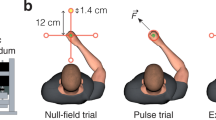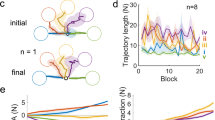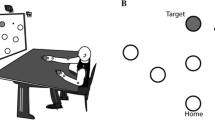Abstract
Coactivation of antagonist muscles is readily observed early in motor learning, in interactions with unstable mechanical environments and in motor system pathologies. Here we present evidence that the nervous system uses coactivation control far more extensively and that patterns of cocontraction during movement are closely tied to the specific requirements of the task. We have examined the changes in cocontraction that follow dynamics learning in tasks that are thought to involve finely sculpted feedforward adjustments to motor commands. We find that, even following substantial training, cocontraction varies in a systematic way that depends on both movement direction and the strength of the external load. The proportion of total activity that is due to cocontraction nevertheless remains remarkably constant. Moreover, long after indices of motor learning and electromyographic measures have reached asymptotic levels, cocontraction still accounts for a significant proportion of total muscle activity in all phases of movement and in all load conditions. These results show that even following dynamics learning in predictable and stable environments, cocontraction forms a central part of the means by which the nervous system regulates movement.






Similar content being viewed by others
References
Bonato P, Roy SH, Knaflitz M, De Luca CJ (2001) Time–frequency parameters of the surface myoelectric signal for assessing muscle fatigue during cyclic dynamic contractions. IEEE Trans Biomed Eng 48:745–753
Burdet E, Osu R, Franklin DW, Milner TE, Kawato M (2001) The central nervous system stabilizes unstable dynamics by learning optimal impedance. Nature 414:446–449
Caithness G, Osu R, Bays P, Chase H, Klassen J, Kawato M, Wolpert DM, Flanagan JR (2004) Failure to consolidate the consolidation theory of learning for sensorimotor adaptation tasks. J Neurosci 24:8662–8671
Darainy M, Malfait N, Gribble PL, Towhidkhoh F, Ostry DJ (2004) Learning to control arm stiffness under static conditions. J Neurophysiol 92:3344–3350
Franklin DW, Burdet E, Osu R, Kawato M, Milner TE (2003a) Functional significance of stiffness in adaptation of multijoint arm movements to stable and unstable dynamics. Exp Brain Res 151:145–157
Franklin DW, Osu R, Burdet E, Kawato M, Milner TE (2003b) Adaptation to stable and unstable dynamics achieved by combined impedance control and inverse dynamics model. J Neurophysiol 90:3270–3282
Gomi H, Osu R (1998) Task-dependent viscoelasticity of human multijoint arm and its spatial characteristics f or interaction with environments. J Neurosci 18:8965–8978
Gribble PL, Ostry DJ (1998) Independent coactivation of shoulder and elbow muscles. Exp Brain Res 123:355–360
Gribble PL, Mullin LI, Cothros N, Mattar A (2003) Role of cocontraction in arm movement accuracy. J Neurophysiol 89:2396–2405
Hwang EJ, Donchin O, Smith MA, Shadmehr R (2003) A gain-field encoding of limb position and velocity in the internal model of arm dynamics. PLoS Biol 1:E25
Lackner JR, DiZio P (1994) Rapid adaptation to Coriolis force perturbations of arm trajectory. J Neurophysiol 72:299–313
Milner TE, Cloutier C (1993) Compensation for mechanically unstable loading in voluntary wrist movement. Exp Brain Res 94:522–532
Perreault EJ, Kirsch RF, Crago PE (2002) Voluntary control of static endpoint stiffness during force regulation tasks. J Neurophysiol 87:2808–2816
Shadmehr R, Mussa-Ivaldi FA (1994) Adaptive representation of dynamics during learning of a motor task. J Neurosci 14:3208–3224
Suzuki M, Shiller DM, Gribble PL, Ostry DJ (2001) Relationship between cocontraction, movement kinematics and phasic muscle activity in single joint arm movement. Exp Brain Res 140:171–181
Thoroughman KA, Shadmehr R (1999) Electromyographic correlates of learning an internal model of reaching movements. J Neurosci 19:8574–8588
Acknowledgments
The authors thank Eric Perreault for comments and Guillaume Houle and Andrew Mattar for technical assistance. This research was supported by NICHD Grant HD-48924, NSERC Canada, and FQRNT Québec.
Author information
Authors and Affiliations
Corresponding author
Rights and permissions
About this article
Cite this article
Darainy, M., Ostry, D.J. Muscle cocontraction following dynamics learning. Exp Brain Res 190, 153–163 (2008). https://doi.org/10.1007/s00221-008-1457-y
Received:
Accepted:
Published:
Issue Date:
DOI: https://doi.org/10.1007/s00221-008-1457-y




